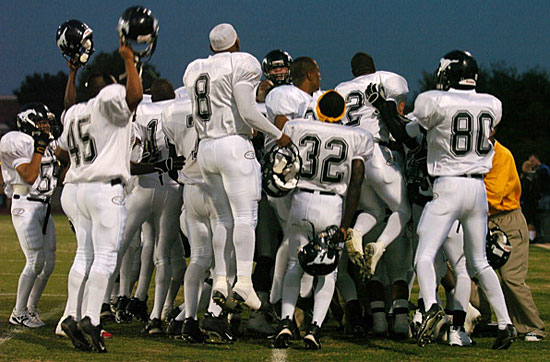Streaming live from the Valley
February 15, 2012

Phase I of the Tujunga Wash Ecosystem Restoration Project has already grown lush. Phase II is underway.
The San Fernando Valley is about to get a little greener. Phase II of the Tujunga Wash Ecosystem Restoration project breaks ground next Wednesday. By the time it’s completed, it will have restored ten acres of open space and created a sustainable stream system in the neighborhood of Valley Glen.
The $7 million project is a joint effort by the Los Angeles County Department of Public Works and the United States Army Corps of Engineers. The area to be restored is 3,000 feet long and 65 feet wide on each side of the wash. The finished section will link two existing “greenbelts”—Phase I of the project and an “original” greenway from the 1970s, forming 13,200 consecutive feet of revitalized land.
For the ecosystem, the project means nesting for migratory birds and a corridor for wildlife movement. Native vegetation will be installed, and the new stream will give local plants a chance to take root. The stream will replenish groundwater and act as a natural filter to urban runoff.
“The goal is to mimic Tujunga Wash in its natural state, but on a smaller scale,” said Richard Gomez, project manager for Department of Public Works.
For humans, the project offers a place to walk, learn and explore. Ornamental gates will mark entry points, a 12-foot-wide path will give pedestrians and bicycles room to meander and educational signage will teach visitors about the local ecosystem and the project itself. Benches and rock wall seating will offer folks a place to rest amid the greenery. Existing chain-link fencing will be replaced with more aesthetically pleasing material.
A ceremonial groundbreaking will take place at 10 a.m. on Wednesday, February 22, at the intersection of Vanowen Street and Fulton Avenue. Speakers include Supervisor Zev Yaroslavsky, Colonel R. Mark Toy and Public Works Director Gail Farber. The public is invited to attend.
The Tujunga Wash feeds into the Los Angeles River in Studio City. In the first half of the 20th century, repeated flooding of the channel caused widespread property damage and even some deaths. As a result, in the 1950s the Army Corps of Engineers lined nine miles of it with concrete. This and other human activity had the unintended effect of eliminating the natural habitat of the waterway.
The longterm hope is revitalization of the entire length of the Tujunga Wash, said Gomez. When the current project is completed this fall, that goal will be 3,000 feet closer.
Posted 2/15/12
One dream, many hands in Metropolis II
February 15, 2012

Many helped build Burden's city, including Rich Sandomeno, Alison Walker and leader Zak Cook. Photo © 2012 Museum Associates/LACMA
Chris Burden’s vast, new miniature skyline may have been one artist’s urban vision, but behind the scenes, it took a village to build “Metropolis II”.
“It was a long process—almost five years—and it took a lot of people,” says the L.A. artist on a recent morning at LACMA, straining to be heard over the din of his creation. The idea, he says, was to evoke the energy of a modern city; around him 4,400 tiny toy wheels on 1,100 toy cars whoosh around an elaborate thicket of toy skyscrapers at up to 240 scale miles per hour.
The room-sized piece, opening to the public January 14, is on long-term loan to the museum from its owner, LACMA trustee Nicolas Berggruen. A big hit in sneak peeks last month, it will be available for viewing anytime, but will only operate Fridays through Sundays, with a special showing on the Martin Luther King, Jr. holiday.
Situated just a short walk from Burden’s iconic “Urban Light,” it is mesmerizing and frenetic, a singular vision of a way of life familiar to every visitor with a car in the parking garage of the museum. But Zak Cook, Burden’s lead engineer, says as many as eight people at a time were assigned to the project, working under the artist’s watchful eye in his rural studio in Topanga.
“In all,” he says, “probably 14 people had a hand in it.”
Hiring crews of assistants isn’t unusual for successful artists, who often need extra hands and special expertise to execute large-scale ideas. “It doesn’t take away from the fact that it’s Chris’ work,” Cook notes. “The work couldn’t exist without Chris. It could exist without me.”
Burden’s crew, like the piece, reflected Southern California: There were two special-effects artists and two college-level art instructors, a maker of artisan snowboards, woodworkers, ceramicists and assorted masters of fine arts from UC Riverside and UCLA. One of the craftsmen on the prototype was the lead guitarist in the L.A.-based band “Dengue Fever.” Much of the infrastructure and train wiring was done by a heavy diesel mechanic-turned-jewelry-designer who was a finalist last year on Lifetime Television’s “Project Accessory.”
Some laid the Plexiglas track. Some built the dreamlike skyscrapers. Some installed the intricate floors and platforms. UC Riverside MFA Alison Walker and the “Project Accessory” finalist Rich Sandomeno came to know the piece so well that LACMA has since hired them to operate and maintain “Metropolis II” and act as a sort of pit crew.
“It was supposed to be a 9-month job and I ended up working on it for three years,” joked Sandomeno. “But it’s been so great to work with Chris and Zak and all the other artists. Besides, he adds: “When I was a kid, I loved Hot Wheels. “
The combination of Burden’s vision and all that painstaking labor is as intricate and playfully serious as art gets—a vast, buzzing skyline that has been compared to New York, L.A., “The Jetsons” and the 1939 World’s Fair. In the course of an hour, the tiny vehicles whip around the thicket of fanciful high-rises a collective 100,000 times on 18 lanes of traffic.
“It’s a city of the past and a city of the future,” says Burden. “It’s a city of the past in the sense that the cars run free, and a city of the future in their speed.”
An earlier, much smaller, version, with only about 80 cars, was built in 2004 for a Japanese museum, Burden says, “but they showed it for six months and then the museum changed direction. “ After the piece was put into storage—“all that work and then nobody got to see it”—Burden decided to make another Metropolis that would be “bigger and better.”
“Metropolis II,” however, took on a life of its own, says Burden: “I think we finished right around the time of Carmageddon. Every building took three or four months, which, I think you could build a tract house in that time.”
Cook served as general contractor for Burden’s architectural direction, working out such not-so-minor details as how to make the cars move reliably. (After much trial-and-error, Cook invented a sturdy, yet invisible, electrically powered conveyance system that hauls the toy cars uphill with magnets, like a rollercoaster, then releases them.)
Burden guided the team closely, Cook says, but also welcomed their input. Many contributed ideas for the exquisite buildings, which the team gave informal names: “AzDec Plaza” was a half-Aztec, half-Deco extravaganza contributed by Walker. An octagonal black high rise with blue windows, built by painter and fellow MFA Greg Kozaki, was known as “DarkTower.” A beautiful blue-and-green glass tile skyscraper was dubbed “Linkous Tower” by Frank Diettinger, a mold-maker who had done special effects for films such as “Sleepy Hollow” and “Bride of Chucky”, and who wanted to honor deceased indie singer-songwriter Mark Linkous.
“Whoever built it got to name it,” says Cook, adding that there was one major exception. “There’s an Eiffel Tower-looking building made from erector set parts, with the uppermost narrow part kind of extended, and Chris named that one.”
“Yeah,” laughs Burden, “I call it ‘Viagra Tower’ because it’s too tall.”
Cook worked on the piece from its inception. Of all the team members, he acknowledges, he probably has the least artistic resume. The 42-year-old son of a former Time correspondent, he graduated from UCLA with a degree in geography and worked for several years in the consulting division of CALSTART, a Pasadena-based clean transportation consortium.
But after a trip to India in 2000, he says, he realized that he didn’t want to keep doing white papers on the environmental impact of ports and airports; he wanted to write fiction and children’s books.
In search of a day job, he got a call one day from a friend who worked for Burden’s wife and fellow artist Nancy Rubins; Burden needed someone to help restore his 1998 sculpture “Hell Gate”, a massive bridge made of erector set pieces. The friend knew that Cook had done construction work in college.
Learning on the job, Cook then went on to help Burden build several more major pieces, including Burden’s 2001 “Bateau de Guerre”, a massive battleship made of gas canisters, and his 2002 model of a British landmark, “Tyne Bridge”.
Burden jokes that Cook “was in charge of work-ethic.”
“He’s very precise and thorough,” says the artist. “I couldn’t have done this work without somebody like him.”
Cook says that now that “Metropolis II” is finished, he intends to return to his own pursuits, and maybe finally finish those children’s stories.
“Not that Chris and I would rule out working together again in the future, but, honestly, this is such a great note to go out on,” he says, watching from a balcony at LACMA as the traffic hums by in the city that he helped make.
“I don’t see how I could ever top this.”

Chris Burden with his creation, created in his Topanga workshop. Photo © 2012 Museum Associates/LACMA
Posted 1/12/12
From pain, pure poetry in Room 219
February 15, 2012

ESL students at Fairfax High turned personal struggles into poetry for a recent performance. Photo/Clive Alcock
The players included a teenager from El Salvador missing her faraway mom, a boy from Africa’s Ivory Coast telling a family secret, a girl from Israel wrestling with what it means to be real, not “plastic.”
They spoke their lines with honesty and transparent emotion. Dressed all in black and moving about a spare stage, they took turns in the spotlight, young faces aglow.
Was this a pitch-perfect ensemble created by a Hollywood casting director? Or maybe an off-Broadway troupe preparing for a long theatrical run?
Hardly. This group came together in Karen Ritvo’s English as a Second Language class at Fairfax High School.
And the words they spoke were true—wrenched from the struggles of their real lives and spun into autobiographical poetry as part of a special collaboration with the Music Center.
When the students took the stage recently for a one-time-only performance at the Greenway Arts Alliance theater on the Fairfax campus, it was the culmination of a creative and transformative process that had started months ago with studying the art of others: Pablo Neruda’s Poetry and Alvin Ailey’s Revelations.
Soon, the students were coming up with revelations of their own, as they began crafting poems based on real experiences of struggle and change.
Some grappled with universal experiences of being a teen—a first kiss, or the heartache posed by a girl wanting to be “just friends.” But many sketched a very specific reality of being young, separated from loved ones and trying to make it in a strange land.
…All I have is her voice on the other
end of the line telling me “Baby everything is gonna be okay.”
That doesn’t take away the pain so I go to bed and wait for the
lights to go down so I can start to cry…
—“How it feels to miss my mom” by Daisy Juarez
Others wrote of the pain of dislocation, and of trying to make sense of a strange new language.
Some strangers just glance at me
This town is a maze
This foreign language sounds like unknown magical words
Colored signs make me confused
I need a new map
To go home to my adorable family
—“A New Map” by Yunha Kim
They described feeling invisible—or, even worse, too visible.
How shy she is in the center of this strange land
Everything she sees is unusual and unfamiliar
No one pays attention to her but she feels only tons of stares on the back of her head
—“Nothing Can Stop Me” by AiLing Lu
So why do you choose to be so rude
If all we want from you is your help to open up
I know you think I’m an alien
But like you I’m from earth
—Untitled, by Sheyla Jordan
Then it was time to move from writing to performing. Madeleine Dahm, a Music Center teaching artist from London, (yes, she’s from someplace else, too) worked with the students to stage a unique production that melded their original poetry with dance moves from Revelations and some recited lines from Neruda.
The show ended with each student speaking their name and where they’d come from: China. El Salvador. Ethiopia. Guatemala. Ivory Coast. Israel. Korea. Mexico. Uzbekistan.
The families, friends, fellow students and well-wishers who’d packed the small theater applauded enthusiastically, some wiping away tears.
“This is as good as education can get, I don’t care what level,” Fairfax principal Ed Zubiate said during a brief Q & A with the performers after the show.
Then it was over. The next week, the end of the semester would scatter the students, breaking up the world they’d formed in Room 219 and bringing down the curtain on all they experienced together.
But not on what they’d learned.
“After the performance, I realized that I don’t need to be afraid of anything,” said Natanel Giladi, 17, of Israel, whose poem “Who I really am” dealt with how hard it is to find one’s true self.
“I feel like wow, I finally said it,” said 17-year-old Kevin Miranda, of El Salvador, who wrote about losing his aunt and grandmother to cancer. “Because I didn’t even talk to my mom about what happened. It was just something I had inside that I didn’t have the opportunity to express. It was my first time on stage.”
“I learned that I’m not the only one who feels weird or feels sad in this country,” said Daisy Juarez, 19, also of El Salvador, who’d written about missing her mom. “They have their problems, too. It’s not only me. I learned not to judge.”

The poet-performers share a moment onstage with Dahm, kneeling at left, and Ritvo, standing center with scarf.
Posted 2/14/12
Game-changer for a probation camp
February 14, 2012

The Malibu probation camp, one of the few to offer CIF sports, is getting a makeover. Photo/L.A. Daily News
Camp Vernon J. Kilpatrick has been rehabilitating troubled teens for generations. Now the famed Los Angeles County probation camp will be getting a rehab of its own.
This week, after nearly a year of analysis and study, the 50-year-old Malibu facility was chosen as the site of a $41 million makeover aimed at making the probation camp system less prison-like and more therapeutic. Underwritten by a $28 million state grant, the project will demolish the aging, 125-bed camp and replace its run-down infrastructure with a state-of-the-art rehabilitative compound.
“This is a real win for the kids who will go to that camp,” says Assistant Chief Probation Officer Cal Remington. “The architecture really does make a difference, and we’re hoping this will become a prototype.”
Camp Kilpatrick’s two residential dormitories will be split into four smaller cottages that will accommodate up to 120 boys, aged 15 to 18. Office and treatment spaces will accommodate counseling and small group meetings, and classrooms and medical facilities will be more intimate and safer. Parking, utilities and security will be updated. Even Kilpatrick’s frayed recreational facilities will be improved—it is one of the few camps in which teens have CIF sports as an incentive for good behavior, and a recreational multipurpose field is included in the grant plans. (This Los Angeles Daily News slide show took a look at the camp’s football team in 2006.)
Research has shown that small group settings are most effective in helping turn around the behavior of incarcerated adolescents, says Remington, but most of the county’s probation camps are built around big, institutional barracks and classrooms that subvert, rather than encourage, introspection and change.
The Los Angeles County Board of Supervisors voted 4-1 Tuesday to replace Camp Kilpatrick, with Supervisor Gloria Molina casting the only “no” vote. The board’s action is the latest move in a longstanding plan to bring the county’s 17 probation camps into the modern era. The camp system houses some 1,300 young offenders, mostly in environments that feel, in many cases, like army outposts.
“All these camps are so old,” says Remington. “And they were all pretty much built according to the thinking of the early 1950s and 1960s, which was a military barracks-type scheme. And that architecture just does not work. When you put 105, 110 kids with school and gang issues into one of these big dorms, it’s just a recipe for more problems. There’s more competition, factions get created, you have gang problems. There’s just something about human nature that people get along better in smaller groups.”
Moreover, Remington says, the system’s operating costs have been soaring as the camps’ infrastructure has degenerated. An analysis by the county Chief Executive’s Office found that Camp Kilpatrick needs some $22.3 million worth of renovations beyond the $1.127 million the county spends, on average, to maintain it annually. Necessary repairs range from the camp’s faltering emergency response system to its gym, which has been yellow-tagged since the Northridge earthquake, and are so extensive that county officials determined it would be cheaper to simply tear it down and replace it.
“The camps are all old,” Remington says. “We just chose Kilpatrick because it was the biggest money pit.”
The state grant—authorized by the 2007 Juvenile Justice Reform Bill, which shiftedCalifornia’s non-violent juvenile offenders into county programs— will pay 75% of the cost of the remodel, with the county anteing up $12.4 million in matching funds. Remington says the department is aiming to have the new camp completed and opened by 2016.
The new design will allow camp supervisors to assign youths to cottages according to their various treatment needs and risk levels, and will create classrooms and treatment areas in which the camps’ charges can focus more easily.
During construction, however, the 100 or so adolescents now being housed at the camp will have to be relocated, and the supervisors instructed probation officials to report back in 90 days with a comprehensive plan. Remington says they will probably be moved in the short term to another camp in the system—one that probation officials hope will have room to continue the sports program.
Posted 2/14/12
Browning tapped for DCFS turnaround
February 14, 2012

Philip Browning brings management turnaround expertise to his new Children and Family Services post.
When it comes to overhauling the county’s long-troubled Department of Children and Family Services, Philip Browning isn’t messing around with any halfway measures.
“What I’d like is within two years to be the national leader, for L.A. County to be the model for other jurisdictions in the child welfare area,” said Browning, shortly after being named to the agency’s top job Tuesday by the Los Angeles County Board of Supervisors. “That’s my goal.”
Browning has been at the helm of the agency for the past six months as interim director. He was originally recruited to come to Los Angeles County in 2001 from Washington, D.C., where he served as the district’s child support director. His first assignment here was to remake the District Attorney’s child support division, one of the most troubled in the nation. With Browning in charge, collections increased 36%, to more than $500 million, as customer service improved dramatically.
“We got more complaints about child support than any other agency in the county before he arrived,” said Board of Supervisors Chairman Zev Yaroslavsky. “He turned it around and now we get virtually no complaints.”
Next up for Browning in 2007 was running the county’s sprawling and complex welfare agency, the Department of Public Social Services. Under his leadership, the department not only kept up with a mushrooming caseload but also radically reduced its error rate in signing people up for food stamps.
“He is a turnaround artist. He’s proven his ability to take a troubled department and turn it around,” Yaroslavsky said, noting that Browning did not apply for the DCFS position but was sought out by the Board of Supervisors.
He hasn’t wasted any time in his new assignment, as he seeks to make over an agency plagued with a series of highly-publicized lapses in protecting vulnerable children under its care.
A dormant strategic plan has been reawakened, with thousands of the department’s 7,300 employees submitting suggestions for initiatives and action items. Browning expects many of them to volunteer to take on new duties as the plan turns into reality.
Meanwhile, monthly meetings with top managers have been shaken up in a big way, with statistics from each DCFS office beamed up onto two huge screens for all to see. It’s part of a “data dashboard’ approach that not only introduces some healthy peer pressure and accountability to the proceedings but also makes it easier for managers to exchange ideas for solving each other’s problems.
“It’s pretty interesting to see the discussion,” Browning says.
He’s also looking for ways to remake the department’s emergency response command post system, which struggles to place children, especially teens and infants, in safe situations after hours.
“They see so many kids late at night that are so difficult to place,” he says. While the overall issue is complex, some simple fixes might be possible—such as forming a foster parents’ association that could help identify families willing to take late-night placements, or providing diapers or extra money to families willing to take on the challenge of caring for an infant.
And he’s getting ready to reorganize. “I’m foreseeing some pretty significant changes,” he says.
When Browning came in as DCFS’ interim director in August, he was the department’s third interim director in nine months. The previous permanent chief, Trish Ploehn, departed amid an uproar over high-profile child deaths and questions about whether the department was being open with policy-makers and the public. Browning’s appointment to the $255,000-a-year post is effective Thursday, Feb. 16.
Browning has a master’s of social work degree, but acknowledges he doesn’t have a deep background in child welfare.
“I think my value is management,” he says. “I see myself as an implementation guy.”
He said that over the course of his career, a variety of assignments—from running a grocery store to managing units responsible for U.S. Navy reserve logistics—have given him the tools to get things done.
Even as he’s thinking big at DCFS, Browning is stressing a simple set of principles to his new workforce.
“Common sense, critical thinking and accountability: I think almost anything you do falls within those parameters,” Browning says. “I have to be accountable, and our staff has to be accountable.”
Posted 2/14/12
Some bookmark artists who love to read
February 14, 2012
Harry Potter, watch your back.
The imaginative visual artists who just won L.A.County’s 32nd annual bookmark contest are an eclectic bunch when it comes to reading.
While J.K. Rowling’s boy wizard remains a favorite, the bookmark winners report enjoying fiction ranging from French existentialism (The Stranger by Albert Camus) to fantasy from Game of Thrones author George R. R. Martin.
Whoopi Goldberg has a following—both her Big Book of Manners and Sugarplum Ballerina series made the kids’ reading list. Roald Dahl continues to be a popular choice. And magic, in all its forms and at all reading levels, remains incredibly popular, from Magyk to the The Magic Tree House series (and, of course, the Harry Potter books.)
Funny titles—from Dork Diaries to Scumble to My Sister the Vampire—were singled out for mention. So were serious works like The Things They Carried, by Tim O’Brien. One student listed the Bible as her favorite book.
The students, whose bookmark illustrations were chosen from among 11,000 entries, were surveyed about favorite books, hobbies and dreams for the future before their appearance at the Board of Supervisors meeting Tuesday. The contest was open to students from kindergarten to 12th grade; entries were judged in separate categories according to grade level.
The winners from the 3rd District are Francesca “Frankie” Lane Manera (Malibu Public Library), Josias Salvador (San Fernando Public Library, Hunter Blaze Pearson (Agoura Hills Public Library) and Irina Tsoi (West Hollywood Public Library.) For a look at all the winning bookmark creations, click here, or stop by a branch of the Los Angeles County Library this spring.
Posted 2/14/12
Beach director says Frisbees are fine
February 9, 2012
Santos Kreimann says he has nothing against Frisbees at the beach—honest. And it’s OK with him if you want to toss a football along the shore, too, as long as you do it responsibly.
That’s why the county’s Beaches & Harbors director was baffled Thursday to find that what his department views as a liberalization of the rules for beach recreation is being widely misinterpreted to mean that Frisbee- and football-throwing is now subject to a $1,000 fine.
Not so, Kreimann says. After years of outright prohibition, a new ordinance which received final approval this week spells out for the first time the conditions under which Frisbees and footballs are allowed on county beaches—basically, in the off-season, or with a permit or permission from the lifeguard.
For years, he said, that kind of recreation had been outlawed altogether “to prohibit some knucklehead from acting like an idiot on the beach.”
The Frisbee flap has received big play on the airwaves and the Internet. The Drudge Report headlined an incorrect report by a local TV station: “LA County Approves $1,000 Fine For Throwing Football, Frisbees On Beaches.” Inquiries have poured into county offices from reporters as far away as London. The Los Angeles Times provided a factually accurate counterpoint to the coverage with an article headlined: “Ball playing, Frisbee tossing now allowed on L.A. County beaches.”
The new ordinance does give the county the right to ticket Frisbee scofflaws, like people who persist in throwing into large summer crowds, or when asked not to by a lifeguard. The first offense is $100—an amount set by the California Government Code. (Read the department’s statement on the ordinance here.)
Still, Kreimann doesn’t expect many citations will be issued.
“We don’t ticket anybody for throwing a ball on the beach, as long as they’re doing it responsibly,” he said.
As for those new $1,000 fines you may have heard about: yes, they’re in the ordinance but they apply to only a few kinds of misbehavior.
Those include nudity, shooting weapons and swimming or surfing during hazardous conditions or in prohibited areas.
The revisions to the ball-playing section of the ordinance were prompted in part by the growing popularity of sports like beach tennis and beach soccer, which are now permissible under certain conditions.
Posted 2/9/12
L.A.’s ballot box language boom
February 8, 2012

From Bengali to Thai, L.A. County voting officials are brushing up on some new languages for voters.
The nation’s most linguistically diverse ballot is about to offer even more ways to say “I voted.”
This June, when the polls open for the 2012 primary elections,Los Angeles County voters will be able to cast ballots in three new languages and receive oral translations in two more.
The addition of written voting material in Hindi, Khmer and Thai, and the planned recruitment of poll workers who can give bilingual assistance in Gujarati and Bengali, will bring to eleven the number of languages—other than English—in which L.A.County citizens will be able to vote.
Ballots and voting literature have been available for at least a decade in Chinese, Japanese, Korean, Vietnamese, Tagalog, Spanish and English. Registrar-Recorder/County Clerk Dean Logan says the additional voting material and recruitment could cost up to $1 million, but is necessary to comply with the federal Voting Rights Act.
That law generally requires language assistance for voters when a non-English-speaking minority exceeds 10,000 voting age citizens or 5 percent of a jurisdiction’s electorate.
“It’s a federal mandate that unfortunately does not come with federal funding, so we have to absorb it into our own budget,” says Logan. “It’s a challenge, but it’s also a great opportunity to ensure that we’re getting information to people in ways that they can access and comprehend.”
Efrain Escobedo, executive liaison forLogan’s office, attributes the need to a number of factors, including an increase in the number of naturalized citizens from India and Southeast Asia, and the migration of Asian-American voters from other states. Escobedo added that this year’s mandate required extra analysis because it was issued not by nationality, but by ethnicity and race.
“They gave us two categories—Asian Indian and ‘Other Asian Non-Specified,’ ” says Escobedo. “But India has over 122 recognized languages and 22 official languages. So when you tell us ‘Asian Indian,’ that doesn’t really help.”
Meanwhile, a search for non-Indian “other” Asian groups that weren’t already getting bilingual assistance yielded more than 80,000 residents of L.A. County with a half-dozen different national origins.
Eventually, Escobedo says, county analysts narrowed the list with the help of targeted census data, community groups such as the Asian Pacific American Legal Center and the Artesia-based South Asian Network and analysis from the Center for the Study of Immigrant Integration at the University of Southern California.
In addition to leading to the new languages on the ballot and in polling places, the county’s research yielded a rough sketch of the county’s dynamic immigrant populations. For instance:
- Los Angeles County now has more than 1.35 million people who identify themselves as Asian.
- The county’s largest Asian community is non-Taiwanese Chinese, which represents nearly 372,000 people or about 27.5 percent of the Asian community.
- Filipinos run a close second with nearly 329,000 residents, or about 24.3 percent of the county’s Asians. Another 216,000 or so residents are Korean, making up about 16 percent of the Asian community.
- More than 76,000 county residents identified themselves as Asian Indian in the 2010 Census, representing roughly 6 percent of the county’s overall Asian population. More than a third were naturalized citizens.
- About 20,000 of the county’s Asian-Indians are registered voters and more than two out of three have a college degree. The vast majority reported fluency in English, but about one in ten said that they don’t speak it well.
- The county’s immigrant population now includes more than 32,000 Cambodians, 23,000 Thais, 10,000 Indonesians, 9,000 Pakistanis, 6,100 Sri Lankans and 3,000 Laotians.
- Four out of every ten Cambodians are naturalized citizens, and more than a third of the county’s Cambodian population is registered to vote. But nearly 40% of Cambodians over age 25 in the county lack a high school diploma, and a third of the county’s Cambodian population speaks English poorly or not at all.
- The county’s Thai community also reports a 42 percent rate of naturalization. But only about 25 percent reported poor skills in English and more than four in ten have college degrees.
- Los Angeles County’s Thai communities are clustered in Cerritos, Glendale, L.A.and Long Beach. Cambodian clusters can be found in Long Beach, Signal Hill, Lakewood and Pomona. Meanwhile, Asian Indians are concentrated in Artesia, Cerritos, Diamond Bar, Walnut and L.A.
Posted 1/31/12
Looking out for shelter pets
February 8, 2012
The Los Angeles County Board of Supervisors this week weighed in on a narrow-but-emotional debate over euthanasia in animal shelters, urging the governor not to repeal a suspended law requiring shelters to wait more than three days before euthanizing abandoned pets and strays.
The mandate, suspended since 2009, is one of more than 30 that Gov. Jerry Brown has sought to eliminate in the wake of the state’s budget crisis.
Signed into law in 1998 by Gov. Pete Wilson, and named for its sponsor, former Santa Monica state senator Tom Hayden, it has extended the lives of lost and stray animals by requiring shelters to hold them from four to six days, rather than the 72 hours under the prior law. Local governments are supposed to be reimbursed by the state.
As California’s economy has struggled, however, the shelter law has been a target. In 2004, Gov. Arnold Schwarzenegger briefly tried and failed to repeal it, and five years later, it was suspended as part of a deal to balance the state budget. At the time, animal rights groups feared that shelters would begin euthanizing animals more quickly, but they continued to abide by longer waiting periods, making up for the lack of state reimbursement out of their own budgets.
In Los Angeles County, for instance, the Department of Animal Care and Control has spent about $600,000 a year of its $33 million budget to hold animals for five days before euthanization, says Chief Deputy Director David Dijkstra.
“As long as we have the ability, we like to make animals available for adoption or owner redemption for as long as possible,” Dijkstra says, noting that the county impounds about 90,000 animals a year and euthanizes fewer than half of them.
Some animal rights activists have argued that Hayden’s Law has worsened conditions for shelter animals because so-called “rescue holds” by hoarders and well-intentioned but disorganized animal lovers force shelters to house aggressive and diseased animals for weeks at the expense of more adoptable pets who then end up being euthanized for lack of space.
The state also points to a 2008 report from the nonpartisan Legislative Analyst’s Office that found no proof that the Hayden Law had led to an increase in pet adoptions, and therefore recommended repeal.
Still, Brown’s proposal to save more than $23 million a year by taking the mandate out of the state budget has drawn a fresh round of protest from some pet lovers and animal rights groups. Hayden recently spoke out in a YouTube video, and the Humane Society of the United States this week asked members to write to Brown.
The Board’s response, led by Supervisor Michael Antonovich, a longstanding advocate for pet adoptions, took the form of a 5-signature letter asking that the law not be repealed.
Quantifying the local impact of Hayden’s Law has been difficult because so many variables are involved in pet adoptions. For example, in recent years, Dijkstra says, shelters have become more crowded because owners have had difficulty caring for pets in this economy. Moreover, many of the 40,000 or so animals euthanized each year in county shelters are animals such as feral cats that can’t easily be placed for adoption.
However, he notes, by the most available measure—dog impounds—the suspension of Hayden’s Law has not increased euthanasia. In 2008-09, the county impounded 45,903 dogs, with 54 percent adopted or returned to their owners. In 2011-12, the projected number of impounded dogs stands at 48,823, with 57 percent returned or adopted.
About 80 percent of pets are claimed by their owners within the first three days, he says, but last year, about 1,100 lost pets were reunited with their owners on their fourth and fifth days in the shelter. In the past year, he adds, the county also has begun putting abandoned pets up for adoption sooner than they might otherwise have been made available.
“It’s very rare that an owner shows up after we’ve made a dog or cat available for adoption,” he adds, “but that has happened on a couple of occasions, and in those cases, the new owners are contacted and asked if they’ll give the pet back.”
Posted 2/8/12














 Check for the latest closure information
Check for the latest closure information








